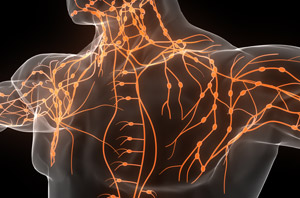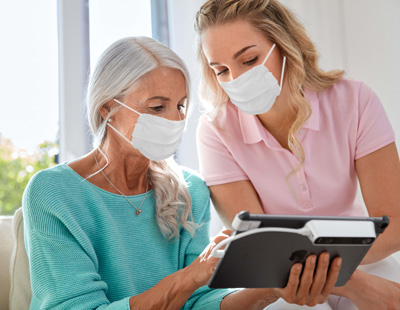What is Lymphedema?
 When the lymphatic system — the organs in your body that defend against infection — is damaged or blocked, it can cause an accumulation of water and proteins in your body’s soft tissues. This can lead to lymphedema — or swelling — which can occur anywhere in the body but is most common in the arms and legs.
When the lymphatic system — the organs in your body that defend against infection — is damaged or blocked, it can cause an accumulation of water and proteins in your body’s soft tissues. This can lead to lymphedema — or swelling — which can occur anywhere in the body but is most common in the arms and legs.
The lymphatic system is part of the immune and circulatory systems. It’s a network of tissues and organs made up of lymph vessels and lymph nodes that drain lymph fluid (which contains white blood cells, water, proteins, salts, and lipids) from all over the body.
The swelling that’s caused by lymphedema occurs slowly over time. It is most often due to cancer treatment resulting in lymph node removal, tissue and lymphatic vessel damage and decreasing flow of lymphatic fluid. For cancer patients, these symptoms may occur shortly after surgery or may develop a year or more after treatment.
Lymphedema may be accompanied by a feeling of heaviness or tightness, difficulty moving, hard skin, folds developing on the skin, pain, or discomfort. Left unmanaged, lymphedema can cause serious complications, including:
- Increased risk of infection in the swollen area because the cells that prevent infection aren’t well circulated in that part of the body.
- Stiffness or soreness in the area.
- Loss of functional mobility and the ability to accomplish daily activities of living.
Additionally, lymphedema may cause people to feel embarrassed, depressed, or frustrated because of how the condition makes them look and feel.
Who’s Most at Risk?
 Lymphedema can affect patients who have been diagnosed with a variety of conditions, including those with damage to their vascular system and those who are experiencing congestive heart failure, a severe infection, or those who are obese.
Lymphedema can affect patients who have been diagnosed with a variety of conditions, including those with damage to their vascular system and those who are experiencing congestive heart failure, a severe infection, or those who are obese.
However, lymphedema occurs most often in patients who are undergoing cancer treatment. While the condition can affect patients with nearly any type of cancer, it’s most common in patients who are being treated for breast, prostate, pelvic, or head and neck cancers as well as lymphoma and melanoma.
The condition can occur as a side effect of surgery (lymph node biopsy or dissection and tumor resection) or radiation, which triggers local inflammation and blocks fragile lymphatic vessels from circulating infection-fighting white blood cells throughout the body. The symptoms of lymphedema often appear in the first year after treatment, but it can happen at any time.
It is important to note, however, that not everyone who has had lymph nodes removed as part of cancer treatment will develop lymphedema.
While there is no sure way to prevent lymphedema, there are ways to lower your risk and reduce its severity. It’s recommended that you maintain a healthy weight, exercise to help the lymph fluid circulate and drain as it should, and do your best to avoid skin infections, burns, and injuries.
What Treatments Are Available?
Though there is no cure for lymphedema, it can often be treated and managed to keep the swelling down and relieve symptoms.
The certified lymphedema therapists in the Lymphedema Program at Princeton Rehabilitation, a program of Penn Medicine Princeton Medical Center, offer one-on-one treatment and education that are tailored to meet each patient’s specific needs.
Treatment may include:
- Exercises aimed at helping lymph fluid drain, decreasing swelling, and improving strength, range of motion, and function.
- Manual lymph drainage massage to help push the fluid out of the swollen area.
- Compression bandaging to encourage removal of lymph fluid in the area.
- Compression garments such as sleeves or stockings can help reduce fluid in the area.
Advanced Technology
Deep Oscillation Therapy: This non-invasive therapy allows for improved lymphatic flow and the elimination of toxins from the body. Through the use of an electrical current that creates deep tissue vibration, patients experience improved reduction of swelling, muscle relaxation, and better pain management. 3D Measuring System: For patients who will benefit from the use of a compression garment, this sophisticated imaging system enables the therapist to quickly capture accurate limb circumference measurements to ensure the proper fit of custom or over-the-counter garments. |
Contact Information
For more information about Princeton Rehabilitation or to find a certified lymphedema therapist please call 609.853.7840 or visit www.princetonhcs.org.
Penn Medicine Princeton Cancer Center
One Plainsboro Road
Plainsboro, NJ 08536
609.655.4586
Monroe Campus
2 Centre Drive, Suite 500
Monroe, NJ 08831
609.655.4586


 The program’s certified therapists are also trained in advanced technology to treat lymphedema, including:
The program’s certified therapists are also trained in advanced technology to treat lymphedema, including: